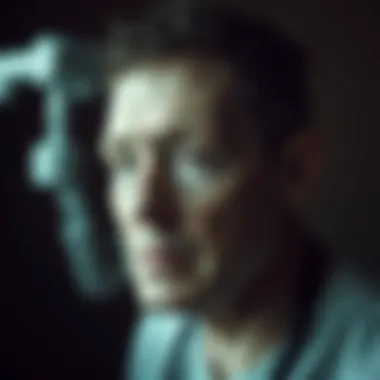Managing Tardive Dyskinesia Without Medication


Intro
Tardive dyskinesia (TD) is more than just a mouthful to pronounce. It signifies a complex neurological disorder marked by involuntary movements, often associated with long-term use of certain antipsychotic medications. However, what's intriguing is that some individuals experience symptoms of TD even without medication. This article takes a closer look at how one can manage these movements without relying on pharmaceuticals. Many people living with TD find themselves in a precarious situation—navigating a life where involuntary movements become a constant companion. Exploring alternatives to traditional treatments opens a new realm of understanding and possibly better quality of life.
Understanding TD goes beyond just recognizing the symptoms; it delves into the neurobiology that causes these involuntary expressions. By shedding light on this hidden aspect, one can grasp the importance of employing a multi-faceted approach—not merely accepting TD as a lifelong sentence.
Key Concepts and Terminology
Definition of Key Terms
- Tardive Dyskinesia: A late-onset movement disorder, usually characterized by repetitive, involuntary movements. This condition can affect various parts of the body, often the face and limbs.
- Neurobiology: The branch of biology focused on the nervous system, essential for understanding the underlying mechanisms linked to TD.
- Pharmacological Treatments: Refers to methods involving medication that are typically employed to alleviate symptoms associated with various disorders, including TD.
Concepts Explored in the Article
This article highlights several crucial concepts related to managing TD without medication:
- Alternative Therapies: Approaches such as occupational therapy, physiotherapy, and relaxation techniques.
- Lifestyle Modifications: Adjustments in daily habits that may help alleviate symptoms, including dietary changes, exercise, and stress management.
- Patient Education: Empowering individuals with knowledge about their condition to make informed decisions regarding their health.
Findings and Discussion
Main Findings
Through an examination of various case studies and research articles, a few consistent themes arise:
- Mind-Body Connection: Many practitioners have noted that controlling stress and anxiety can significantly impact the severity of symptoms. Practices like mindfulness meditation and yoga have shown promise.
- Dietary Influence: Certain dietary changes, like incorporating more antioxidants and omega-3 fatty acids, may have a positive effect on movement disorders. Foods rich in these nutrients appear to support overall neurological health.
- Physical Activity: Engaging in regular exercise is not only crucial for physical well-being but also boosts mood and can help alleviate some movement issues. For some, even simple activities like walking or swimming work wonders.
"Managing symptoms of tardive dyskinesia requires a comprehensive understanding of both the individual condition and the broader health context in which it resides."
Potential Areas for Future Research
This area presents numerous opportunities for exploration:
- The long-term effects of mind-body interventions on TD symptoms.
- Specific dietary influences and how they relate to the neurobiology of TD.
- The role of community support groups and patient education in affecting symptom management positively.
For further reading, visit resources such as Wikipedia and Britannica.
Understanding Tardive Dyskinesia
Tardive dyskinesia, often abbreviated as TD, is more than just a concern for those who are prescribed antipsychotic medications; it's a disorder that impacts daily life in profound ways. A deep understanding of this condition is crucial not only for medical professionals but for patients, caregivers, and society at large. Recognizing the various facets of TD lays the groundwork for exploring non-medication strategies to manage its symptoms, which can be a game changer for many.
The importance of genuinely understanding tardive dyskinesia cannot be overstated. It goes beyond mere recognition of involuntary movements. Grasping its definition, recognizing the historical context behind its identification, and knowing the epidemiological details surrounding the disorder helps shape a comprehensive perspective. This is especially pertinent given that many people with TD may feel isolated or misunderstood, leading to stigmatization that affects their mental well-being.
What often accompanies a diagnosis of TD is a sense of confusion. Patients may face challenges in articulating their experiences, leading to frustration. Thus, an informed approach can foster better communication between patients and healthcare providers. When everyone involved is on the same page, it paves the way for implementing various management techniques that don’t rely solely on medication.
Definition and Overview
Tardive dyskinesia is characterized by repetitive, involuntary movements that often involve the face, tongue, and limbs. While the term 'dyskinesia' suggests movement disorders, the implications extend to emotional and psychological realms. It's not uncommon for individuals to experience noticeable tics, grimacing, and other peculiar movements.
The onset of TD can develop after prolonged exposure to dopamine receptor antagonists, usually prescribed for psychotic disorders. However, it should be noted that not everyone who takes these medications will develop TD. The symptoms can be distressing and significantly impair one’s quality of life, turning simple everyday tasks into major hurdles.
Historical Context
The recognition of tardive dyskinesia has evolved since it was first addressed in the medical literature during the late 1950s and early 1960s. Initially, this phenomenon was primarily seen among chronic patients undergoing treatment with antipsychotic drugs. Early misconceptions linked TD strictly to the medication itself, but further research unveiled a more complex interaction involving neurobiology and individual patient predispositions.
There was a time when TD was not only stigmatized but also considered a shameful side effect, further adding to the burden of those affected. This historical backdrop is key to understanding the challenges faced by individuals grappling with TD today. It highlights how critical awareness and education have become in driving change toward more effective communication and peer support, as well as advocacy for non-medication options.
Epidemiology
Understanding how widespread tardive dyskinesia is sheds light on its significance. Estimates suggest that TD may affect up to 30% of long-term users of antipsychotics. Interestingly, this condition doesn't discriminate; it can manifest in men and women across varying ages and backgrounds, though it appears to be more prevalent in older patients, particularly women.
The epidemiological aspect also indicates a troubling reality: the longer one is exposed to antipsychotic medications, the higher the risk of developing TD. Moreover, those with certain genetic predispositions may be at a greater risk, adding yet another layer to the complexity of this disorder. Studying the patterns of prevalence and incidence allows researchers and practitioners to better understand which populations might require more vigilant monitoring or alternative therapies.


In summary, a comprehensive grasp of tardive dyskinesia begins with understanding its definition, history, and prevalence. This knowledge serves as a foundation for exploring management strategies that steer clear of pharmacological interventions, ultimately empowering those afflicted with the disorder. The complexities surrounding TD underscore the need for a multidimensional approach that embraces various forms of support and therapy.
Pathophysiology of Tardive Dyskinesia
Understanding the pathophysiology of tardive dyskinesia (TD) is crucial for comprehending the disorder beyond just its clinical symptoms. This section delves into the underlying mechanisms and their implications for managing TD effectively without medication. By grasping how TD operates within the nervous system, healthcare professionals and caregivers can tailor their strategies to alleviate the symptoms through non-pharmacological means. An appreciation of TD's pathophysiology lays the foundation for exploring alternative treatments that consider neurochemical and genetic factors, ensuring a comprehensive approach to symptom management.
Neurochemical Mechanisms
To fully appreciate tardive dyskinesia, one must consider the complex neurochemical processes at play. Primarily, the disorder is associated with the dysregulation of dopamine receptors, particularly the D2 subtype. Over time, long-term exposure to certain antipsychotic medications can lead to changes in the sensitivity and density of these receptors, resulting in the involuntary movements characteristic of TD.
- Dopaminergic pathways, especially in the basal ganglia, are central to movement control. Abnormalities in this system can precipitate the involuntary movements seen in TD.
- Furthermore, glutamatergic and gamma-aminobutyric acid (GABA) systems may also play a role in modulating symptoms. Glutamate, as an excitatory neurotransmitter, and GABA, as an inhibitory one, create a delicate balance for motor control.
The interplay between these neurotransmitters and their receptors illustrates how a disturbance in this balance can lead to TD. Ongoing research continues to unravel these neurochemical intricacies and may inform future non-medication interventions aimed at restoring this balance.
Genetic Predispositions
Genetic factors may also contribute to an individual's susceptibility to developing tardive dyskinesia. Some people seem to have a genetic makeup that makes them more prone to this condition, especially when exposed to antipsychotic medications.
- Variants in specific genes can influence how one metabolizes drugs, which may impact the likelihood of developing TD.
- Studies have identified several genes involved in dopaminergic pathways (e.g., COMT, DRD2), which may help explain why some individuals develop TD while others do not under similar treatment circumstances.
Research is attempting to clarify these genetic predispositions, which could eventually lead to better predictive models for assessing the risk of TD in patients. Identifying individuals at higher risk allows for the implementation of non-drug strategies, possibly preventing the onset of symptoms before they take root.
The insights gained from both the neurochemical mechanisms and genetic predispositions provide fertile ground for developing personalized, non-medical management plans for those grappling with tardive dyskinesia. Understanding these elements is vital for healthcare providers, caregivers, and affected individuals as they navigate the complexities of this condition.
Diagnosis of Tardive Dyskinesia
The diagnosis of tardive dyskinesia plays an integral role in effectively addressing the complexities of this disorder. Proper diagnosis sets the stage for understanding the underlying causes and tailoring appropriate intervention strategies that steer clear of pharmacological treatment. It allows patients and healthcare providers alike to navigate the multifaceted challenges associated with TD while fostering a clearer comprehension of the disorder’s implications on daily life and overall wellbeing.
Key benefits of accurately diagnosing tardive dyskinesia include greater awareness and education about the disorder, facilitating timely access to non-medication management options. Early identification can make a world of difference, preventing the potential worsening of symptoms. Furthermore, recognizing TD paves the way for discussions around alternative therapies and lifestyle adjustments that can improve the quality of life for the affected individuals.
However, the path to diagnosis often involves several nuanced considerations, and it requires the expertise of healthcare professionals who have experience with movement disorders. The more informed and equipped the diagnostic team is, the better they can support the patient’s journey toward symptom relief.
Clinical Assessment
A clinical assessment for diagnosing tardive dyskinesia consists of a thorough evaluation of the patient's medical history, presenting symptoms, and a physical examination. Here, the healthcare provider will focus on signs such as involuntary movements, which may manifest in the face, limbs, or trunk. Assessing the frequency, duration, and triggers of these movements are crucial parts of the process.
- Patient History: The clinician will often inquire about prior medication use, particularly antipsychotics, along with the duration and dosage. They may also look into other factors, including:
- Movement Assessment: Tools such as the Abnormal Involuntary Movement Scale (AIMS) can be utilized during the physical examination. This standardized scale guides clinicians in quantifying types and severity of movements, providing a clearer picture of the patient's condition.
- Family history of neurological disorders
- Coexisting medical conditions
- Previous treatments attempted
In essence, a well-rounded clinical assessment not only serves to identify TD but also aids in forming a comprehensive treatment plan tailored to individual needs.
Differential Diagnosis
Differential diagnosis is paramount when considering tardive dyskinesia, as other movement disorders may present in ways that overlap with TD. The purpose here is to distinguish TD from conditions like Parkinson's disease, dystonia, or essential tremors, which may require different management strategies.
Some critical points in differential diagnosis include:
- Timing of Symptoms: Evaluating when symptoms appear in relation to medication initiation is vital. In TD, symptoms usually surface after months or years of anti-psychotic treatment, while other disorders may have more immediate onset.
- Clinical Features: Specific features help differentiate TD from other disorders. For instance, the rhythmic movements seen in Parkinson’s might be distinct from the sporadic and jerky movements characteristic of TD.
- Other Diagnostic Tools: Sometimes, neurologists will use imaging tests, such as MRI or CT scans, to rule out structural causes of the symptoms.
In summary, precise differentiation not only confirms the diagnosis of tardive dyskinesia but also helps tailor non-medication strategies that resonate with the patient’s situation. The importance of diagnosis cannot be overstated; it lays the groundwork for a holistic and personalized approach to managing tardive dyskinesia effectively.
Non-Medication Strategies for Management
Managing tardive dyskinesia (TD) without pharmaceuticals is not simply a secondary option; it can be a lifeline for those grappling with the involuntary movements and distress that accompany the disorder. Patients often face a complex maze of symptoms that can substantially impact daily living. Therefore, tapping into non-medication strategies is crucial to help alleviate symptoms, enhance quality of life, and promote overall well-being. These methods, while not universally effective, provide an alternative pathway that might be better suited to individuals for whom medication is either not an option or has been ineffective.
Behavioral Techniques
Behavioral techniques play a pivotal role in managing TD symptoms. They focus on altering specific actions and responses to help mitigate involuntary movements. For instance, re-training one’s habitual movements can prove invaluable. Patients can work with a behavioral therapist to establish new, more intentional patterns of movement, thereby reducing the prominence of dyskinetic movements in certain contexts.
Consider the scenario of someone who finds themselves tapping their foot involuntarily in a meeting. Through behavioral therapy, this individual might learn to substitute that movement with subtle hand gestures or deep breathing exercises whenever the urge arises. The ability to redirect focus onto constructive habits rather than involuntary ones can be a game changer.


Cognitive-Behavioral Therapy
Cognitive Behavioral Therapy (CBT) is another promising avenue for managing tardive dyskinesia. This therapy intertwines cognitive processes with behavioral patterns, fostering a mindset that can offer relief from distressing dyskinetic episodes. By identifying negative thoughts related to the disorder and systematically reframing them, individuals can cultivate resilience against the psychological toll TD can exert.
While traditional CBT techniques emphasize reducing anxiety and depression, a specific focus on habit reversal can provide tailored strategies to diminish the visibility of involuntary movements. For example, patients can learn to recognize and replace dyskinetic actions with healthier responses, wielding their mind as a tool for transformation.
"The mind can often work in tandem with the body; where the mind leads, the body often follows."
Mindfulness and Relaxation Techniques
Incorporating mindfulness and relaxation techniques into one's daily routine can significantly lessen the debilitating effects of tardive dyskinesia. Mindfulness encourages individuals to ground themselves in the present moment, which can help reduce anxiety that may exacerbate symptoms. Techniques such as meditation, slow breathing, or guided imagery can create a serene internal environment. This peaceful state can, over time, help in managing motor symptoms associated with TD.
Practically, someone might begin their day with just a few minutes of focused breathing, using a simple mantra to tether their thoughts and feelings. Engaging in regular mindfulness practices fosters self-awareness, which can help individuals recognize triggers that prompt involuntary movements and devise strategies to cope better during those episodes.
Physical Therapy and Exercise
Physical therapy and structured exercise programs are vital components of a non-medication strategy to manage tardive dyskinesia. Engaging in regular, tailored physical activity can not only enhance overall physical health but also promote neuromuscular control. Through exercise, individuals can learn how to better manage their involuntary movements and improve their body's overall function.
Therapists can introduce a variety of movements designed to strengthen muscle control and coordination. For example, gentle yoga or tai chi can help improve balance and flexibility while providing participants with a sense of community. Exercise also releases endorphins, which can elevate mood and create a positive feedback loop, helping reduce stress and anxiety that might worsen symptoms.
Diet and Nutrition in Tardive Dyskinesia
Diet and nutrition play a critical role in managing the symptoms and overall health of individuals suffering from tardive dyskinesia. Understanding the link between what we eat and neurological well-being can provide patients with a powerful ally in their journey. An intentional approach to diet not only supports physical health but can also help in alleviating some of the involuntary movements associated with this disorder.
Adequate nutrition helps to nourish the brain and nervous system, potentially influencing the severity and frequency of symptoms. When individuals with tardive dyskinesia adopt a well-balanced, nutrient-rich diet, they may experience improvements in their condition. The following sections will delve deeper into how nutrition impacts neurological health, followed by specific nutrients and supplements that can be beneficial.
Role of Nutrition in Neurological Health
Nutrition is fundamental to maintaining optimal brain function. The brain is a calorie-hungry organ, utilizing about 20% of the body’s total energy. This means that our choice of foods can significantly affect cognitive functions and emotional well-being.
Here are a few key points demonstrating the role of nutrition in neurological health:
- Antioxidants: Nutrients such as vitamins C and E, along with beta-carotene, help combat oxidative stress in the brain. Oxidative damage has been linked to neurodegenerative diseases.
- Omega-3 Fatty Acids: Found primarily in fish like salmon and walnuts, these essential fats are known to support neuronal health, potentially aiding in the reduction of involuntary movements.
- Vitamin B Complex: Some studies suggest a correlation between vitamin B deficiencies and neurological disorders. B vitamins are crucial for energy production and cognitive performance.
- Hydration: Often overlooked, proper hydration supports brain function and overall health. Dehydration can lead to complications including dizziness and confusion, worsening the symptoms of tardive dyskinesia.
The understanding of nutrition’s role is gradually shifting towards a more appreciative view. The right dietary choices can provide not just energy but also a foundation for better management of neurological health.
Specific Nutrients and Supplements
Certain specific nutrients and supplements have been highlighted in various studies for their potential benefits in managing tardive dyskinesia. While every individual's body reacts differently, incorporating these might be worth considering:
- Magnesium: This mineral may help ease muscle spasms and involuntary movements. Foods rich in magnesium include leafy greens, nuts, and whole grains.
- Coenzyme Q10: Known for its antioxidant properties, some research indicates that CoQ10 can assist in brain health and support energy production at the cellular level.
- Ginkgo Biloba: This herbal supplement is often explored for its reputed benefits in Alzheimer’s disease and may have a positive effect on blood flow to the brain.
- Probiotics: Emerging evidence suggests a gut-brain connection where a healthy gut flora positively impacts mental and emotional well-being. Probiotics can be found in foods like yogurt and fermented products.
- Zinc: This trace mineral is vital for neural activity and may have a role in modulating dopaminergic pathways, possibly impacting movement disorders.
"Diet is not just what you eat; it is also what you enable to happen with your health and mental well-being."
While it’s important to discuss any dietary changes or supplements with healthcare professionals, embracing a nutritionally rich lifestyle holds promise for individuals dealing with tardive dyskinesia. Learning about and implementing these strategies could create a significant positive impact on quality of life.
Support Systems and Resources
Support systems and resources play a pivotal role in managing tardive dyskinesia, especially when patients seek alternatives to medication. These networks not only provide essential emotional support but also facilitate access to valuable information and resources tailored to individual needs. The complexities surrounding tardive dyskinesia demand a community approach, where individuals facing similar challenges can share experiences and strategies. Here, we'll delve into the importance of these support systems and the vital role they play in enhancing the quality of life for those affected.
Support Groups and Community Resources
Support groups represent a cornerstone for many individuals dealing with tardive dyskinesia. These gatherings, whether in-person or online, allow participants to share their journeys, effectiveness of various non-medication strategies, and feelings of isolation. By voicing their struggles, patients can discover they are not alone, which can foster a sense of solidarity.
Benefits of support groups for tardive dyskinesia include:
- Emotional Well-being: Sharing personal experiences can provide relief from feelings of frustration and anxiety. Participants often leave meetings feeling understood and validated.
- Information Exchange: Members frequently share knowledge about the latest research, alternative therapies, and coping techniques that have worked for them, enriching each other’s understanding of their condition.
- Resource Accessibility: Many groups offer contacts for specialized therapists, nutritional experts, or even legal advice on healthcare options.
Community resources also play a significant part in supporting individuals with tardive dyskinesia. Local health departments, nonprofits, and outreach programs can provide workshops or educational sessions. Not only do these resources impart knowledge about the disorder, but they also equip participants with practical tools they can use. Online forums, such as those found on reddit.com or specialized Facebook groups, also offer platforms for users to discuss their experiences and advice.
Having the right support can lead to better outcomes, not just for individuals, but for families too.


The Role of Family and Caregivers
Family members and caregivers are often the front-line warriors in the fight against the challenges posed by tardive dyskinesia. Their understanding, compassion, and willingness to learn about the condition significantly impact an individual’s journey toward managing symptoms without medication.
The involvement of family and caregivers can be broken down into several key aspects:
- Understanding the Condition: Caregivers equipping themselves with knowledge about tardive dyskinesia will better understand behaviors and symptoms, creating a more harmonious environment.
- Providing Emotional Support: A supportive family member can cushion the emotional blows that come with living in a body that does not always cooperate. Their encouragement can help individuals maintain their self-esteem and motivation.
- Coordination of Care: Family can assist in organizing appointments, therapy sessions, and check-ups, ensuring that treatment approaches and support systems run smoothly.
- Advocacy: They can serve as advocates, either in healthcare settings or through community resources, ensuring that their loved ones receive necessary support and understanding.
- Encouragement toward Lifestyle Changes: Family members can encourage healthy lifestyle modifications, like community engagement, exercise, and dietary improvements, which are pivotal in managing tardive dyskinesia.
In summary, support systems, comprising both community groups and involvement from family and caregivers, provide an essential framework for those dealing with tardive dyskinesia. Together, they foster a spirit of resilience and hope, breaking the isolation often felt by individuals navigating this challenging condition. For further resources and support, websites like ninds.nih.gov and the National Alliance on Mental Illness (nami.org) can offer additional guidance and connections to both local and virtual support networks.
Future Directions in Research
Research in tardive dyskinesia (TD) continues to advance, highlighting the necessity for fresh methodologies in understanding and treating the disorder without resorting to medication. This importance is underscored by the increasing number of individuals affected by TD, particularly those who experience symptoms as a result of long-term antipsychotic use or other related medications. The multifaceted nature of TD demands that researchers not only focus on symptom management through non-pharmacological methods, but also delve into preventative strategies, which could ultimately reduce the incidence of this condition.
Emerging studies emphasize the necessity of a holistic view towards treatment. This includes integrating insights from neurology, psychology, and even dietetics to formulate a comprehensive approach. By collaborating across disciplines, researchers can explore unique treatment options that engage both the body and mind. Given the often underfunded nature of TD research, there’s a crucial need for advocacy within academic circles and by patients themselves, urging institutions to prioritize this area of study.
As the understanding of the neurobiological underpinnings of TD evolves, it's essential to explore:
- Novel therapeutic techniques, including neurofeedback and transcranial magnetic stimulation, which leverage the brain's plasticity for symptom management.
- The exploration of cannabinoids, which some early research suggests may alleviate specific symptoms experienced in TD.
- The adaptation of technology-based solutions, such as mobile apps for monitoring symptoms, that enable patients and caregivers to identify triggers and manage symptoms more effectively.
“Without a doubt, investing in the future of TD research is not just about developing new therapies; it’s also about improving quality of life for those affected.”
Emerging Treatments and Therapies
Emerging treatment options for tardive dyskinesia focus on integrating lifestyle changes with innovative therapies. These approaches aim to reduce symptoms and enhance overall well-being without the use of pharmacological interventions. For instance, mindfulness-based therapies have shown promise in decreasing anxiety and improving cognitive control, which in turn may help manage involuntary movements associated with TD. The incorporation of movement therapies, like yoga or tai chi, is also being explored. These ancient practices not only promote physical activity but also foster a deeper connection between the mind and body.
Research into specific nutrient deficiencies that contribute to TD has led to the proposal of targeted dietary adjustments, which could serve as adjunctive therapies. For example, studies hint that increasing omega-3 fatty acid intake may reduce inflammation, potentially benefiting neurological health.
Ethical Considerations in Research
Ethics in research concerning tardive dyskinesia plays a pivotal role, particularly regarding informed consent and the vulnerability of affected populations. Patients with TD might have diminished capacity for decision-making due to their condition, raising questions about what constitutes informed consent. Researchers must navigate the complexities of gathering accurate data while ensuring that participants are fully aware of the potential risks and benefits involved.
Another ethical consideration involves the balance between innovation and safety. While exploring new therapies, it is vital to maintain rigorous standards to avoid exploiting vulnerable patients. The ethical landscape calls for constant dialogue among researchers, ethicists, and patient advocacy groups to ensure that the rights and well-being of participants are safeguarded throughout the research process. As the field advances, it should commit to transparency, thoroughness, and the ethical conduct of studies aimed at finding solutions for those affected by tardive dyskinesia.
For continuity in research and action, it's important to connect with ongoing forums and institutional resources that delve into the ethical implications surrounding TD research outcomes. Websites like PubMed, ScienceDirect, and the American Journal of Psychiatry serve as valuable resources to stay updated.
Ending
The exploration of tardive dyskinesia (TD) without medication highlights a crucial frontier in understanding and managing this often-challenging condition. As it stands, the insights provided not only cater to the immediate needs of patients but also pave the way for more comprehensive management strategies that do not rely solely on pharmacological interventions.
Summary of Key Findings
In summary, we have navigated through various aspects of TD management. Critical elements include:
- Behavioral Techniques
- Cognitive-Behavioral Therapy
- Physical Therapy and Exercise
- Dietary Considerations
- Support Systems
- Future Research Directions
- Employing habits that help manage involuntary movements.
- Fostering coping mechanisms through targeted therapy sessions.
- Engaging in routines that enhance motor control and overall well-being.
- Nutritional adjustments that may support neurological health.
- Building a reliable network of community, family, and resources for emotional and practical backing.
- Continuous examination of emerging therapies that might offer new hope to those affected by TD.
The confluence of these strategies not only creates a multifaceted approach but also emphasizes the individual experiences of each patient, respecting their unique journeys.
Implications for Patients and Caregivers
For patients grappling with tardive dyskinesia, embracing non-medicated routes can be both empowering and daunting. The implications are far-reaching. By incorporating strategies such as mindfulness, exercise, and establishing robust support networks, patients can potentially reclaim aspects of their lives that TD may have overshadowed. Caregivers, on the other hand, play a pivotal role in this process. They stand as both advocates and co-participants in managing the daily challenges.
Moreover, education extends beyond mere awareness. It allows for informed decision-making and better adaptation to the condition. Caregivers must educate themselves about the nature of TD, the management techniques available, and the emotional landscape that often accompanies such disorders. Consequently, this creates an environment where both patients and caregivers navigate the complexities of TD together, fostering resilience and an enhanced quality of life.
Ultimately, recognizing and addressing the challenges posed by tardive dyskinesia through non-medication strategies encourages a more holistic understanding of patient care. This perspective not only transforms the approach to learning about TD but also ignites discussions that could lead to breakthroughs in future research.







